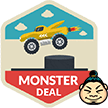If marketing was a Sci-Fi movie, landing pages would be portals – and you can easily tell why. When designed and placed strategically, they ensure two worlds – your website and your visitors – get in contact without any friction.
But more than that, your ultimate goal is to increase conversion rates, so landing page optimization is something you can’t overlook.
Especially if you take into consideration that raising the number of landing pages can result in up to 55% growth in conversion rates.
Obviously, you don’t want to create more of these just for them to become art for art’s sake, so you may want to check the tips below before making your next move in the marketing land.
1. Know What You’re Going After
Although crafting a landing page does not seem like such a complicated process, it certainly involves much more than just putting a bunch of elements together.

For instance, it’s crucial you are clear on the metrics you want to achieve.
What should be the focus of a landing page? SEO, conversions – or both? The answer is in your hands. The essential aspect here is to decide from the start.
Set a clear goal which is also aligned to your overall marketing strategy and, most of all, brings the most ROI (Return on Investment).
For an eCommerce, it’s best to convert the visitors which are already coming in. In this case, landing page optimization should focus on presenting the value of the product you’ve set the landing page for.
For a startup, it may be better to build a strong fan base – which equals a spike in traffic figures. You can achieve that by offering something your audience would find valuable (eBooks, coupons, case studies) in exchange for signing up.
2. Landing Page SEO
And here I’m going into slightly more technical stuff. If you’re not really the SEO specialist (yet), don’t fret – I’ll also share a solution.
First off, I comprised an SEO checklist:
- Use relevant titles and tags.
- Make sure the metadata is to the point.
- Integrate the keyword phrase in the URL of the page.
- All your images should have a fitting size.
Now, to save you time and effort, WordPress SEO Plugins offer metadata management features, so make sure you either get one for your website or explore the plugin you already have.
3. Design
To be honest, landing page design is my favorite part as it grants us the opportunity to experiment with placement, color or size.

After all, preparing to make a smashing first impression is what we do in our day-to-day lives as well, so why not apply the same principle when it comes to landing page optimization?
In short, here are some steps to be completed for your design to have the most impact:
- Choose a design layout which fits your purpose.
- Make the design eye-catching, but pleasant. You can lose half your traffic just because you have an unfitting design which isn’t appealing or doesn’t make sense for navigation.
- Prepare several mock-ups to see how design influences your SEO work. Test different CTA buttons formatting and try out color schemes based on effective contrast.
4. Copywriting
Just because it’s a landing page, it doesn’t mean it’s easier for you in the writing department. On the contrary. It’s more difficult to write content which is concomitantly:
- Concise
- Compelling
- Distinctive
- Informative
In fact, combining all these four attributes is one of the most sought-after writing skills and only the seasoned pros master it effortlessly.
The content people see on your landing page has to be subtle, yet powerful, which is feasible if you take care of:
- Headlines – go for word combinations which pop up, without overusing them.
- Keyword – make sure it is the same throughout the whole page (and don’t forget to place at least 2 of them within the first 100 words).
- Call to Action – rather than too aggressive or salesy, it should give visitors a relevant reason to click on it.
5. Indexation
Depending on the type of landing page you’ve created, you can decide whether you want Google to index that page or not.
You’ll want high-converting pages which bring leads, for instance, to be ranked as high as possible.
PPC landing pages, however, are one-time, campaign-based items, so it doesn’t really make sense to index them. Plus, you also need to monitor PPC traffic, which cannot be super specific if people get to the landing page via search.
In which case, you can tell Google you don’t want them indexed (use an SEO plugin’s sitemap settings to do this – this is what Squirrly SEO Plugin’s looks like).
6. Track the Right Metrics from the Get-Go
Although conversions are the ultimate goal of a landing page, it doesn’t mean they’re also its ultimate use. There are other metrics to be tracked – if you know which ones to go for:
- Bounce rate. The higher it is, the more you can use it as a prop for investigating user experience blunders or ways to improve your website so as to be more intuitive. A high bounce rate on your landing page tells you visitors might leave your site due to: website design, difficult navigation, ineffective CTAs, loading speed.
- Traffic sources. Understanding where your visitors come from is essential when you want to be strategic about your campaign. The first step to take is including the Google Analytics script within the landing page and set up the Facebook Pixel for your Facebook business page, so you can take extra steps towards understanding your audience.
- Time on page. Keep in mind this is a landing page, not a home or product page, so you should get low time on page metrics. If otherwise, it means people spend too much time on the page before converting – which is a telling sign you have to guide them more efficiently to clicking that CTA button.

7. Custom URL
Whatever landing page tool you are using, you should be given the option to post your landing pages to your domain.
This way, the landing page URL will look like an organic component of your website, so it will come across as a completely professional and trustworthy item.
Not to mention, a custom URL allows you to increase the SEO value of a landing page since you can get very specific metrics for it. You’ll be able to run multiple landing pages, each with their own custom URL optimized for different keywords and funnels. Plus, custom URLs can be displayed within off-site marketing campaigns as well.
Key Takeaway for Your Landing Page Optimization Plan
All things considered, a landing page is not always just a short-term item you can dispose of after a few days of campaigning.
All the SEO tips I talked about are the proof content marketers have to up their game even for the tiniest piece of content they create. The more attention you put into optimizing it, the more relevant results it will bring.
And if on top of great content you also tweak the landing page SEO, you’re in for promising conversion rates growth. The great part is landing page optimization can be easily carried out using a WordPress SEO Plugin like Squirrly’s. Now put this info into your ‘no excuses’ file and start chasing those conversions.












